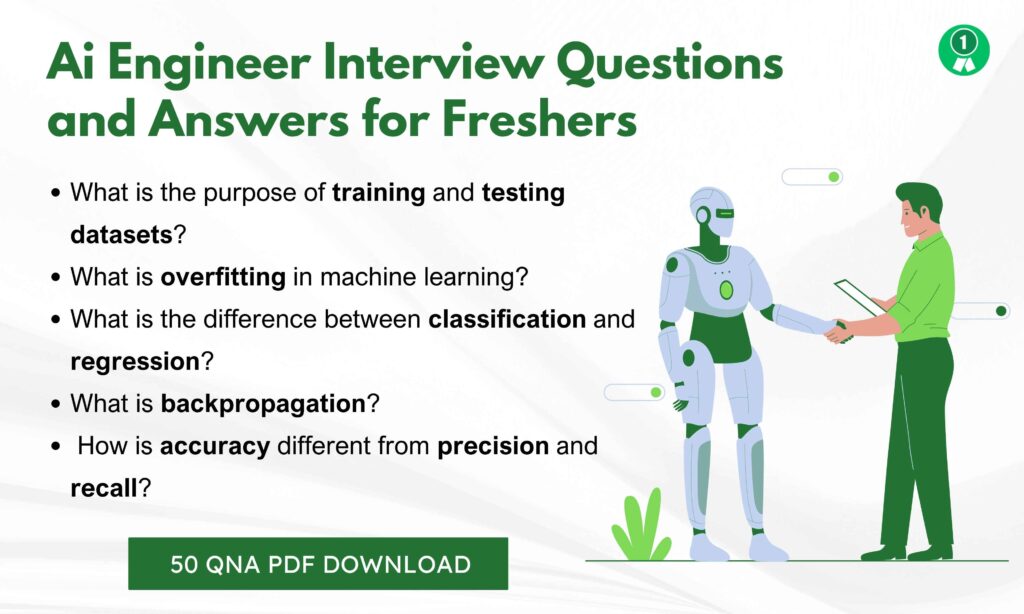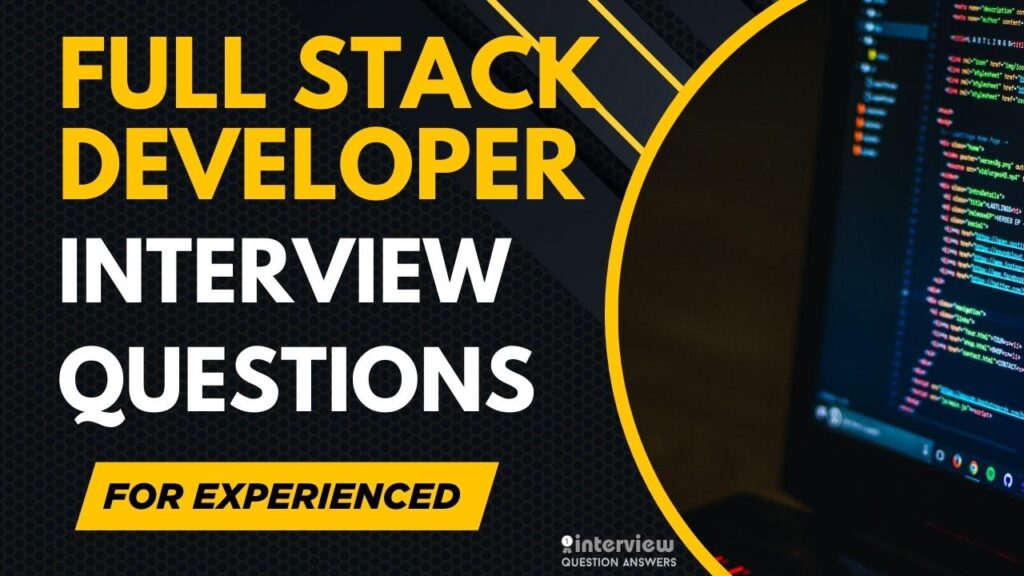An AI Engineer is a professional who builds intelligent systems that can learn and make decisions like humans. They develop machine learning models, work with data, and create AI solutions for real-world problems. These engineers need strong technical skills in programming languages like Python, machine learning frameworks, mathematics, and cloud platforms.
Preparing for AI engineering interviews is essential because the field is highly competitive and requires demonstrating both theoretical knowledge and practical problem-solving abilities. Here we’re sharing popular interview questions and answers to help you prepare effectively.
We’re also providing a downloadable PDF so you can study offline and boost your confidence for landing your dream AI engineering role.
Table of Contents
Junior AI Engineer Interview Questions and Answers for Freshers
Let’s begin with the basics. If you’re a fresher applying for an entry-level AI engineer role, here are some common questions you might encounter in your interview.
1. What is the difference between AI, Machine Learning, and Deep Learning?
Answer:
- AI is the broader concept of machines being able to carry out tasks in a smart way.
- Machine Learning is a subset of AI that allows systems to learn from data.
- Deep Learning is a subset of Machine Learning using neural networks with multiple layers.
2. What is supervised learning and give an example?
Answer:
Supervised learning uses labeled data to train models. Example: Predicting house prices based on historical data where the price is known.
3. What are some commonly used Python libraries in AI?
Answer:
| Library | Purpose |
|---|---|
| NumPy | Numerical computations and array operations |
| pandas | Data manipulation and analysis |
| scikit-learn | Machine learning algorithms and models |
| TensorFlow | Deep learning framework |
| PyTorch | Deep learning framework |
| OpenCV | Computer vision and image processing tasks |
4. What is the purpose of training and testing datasets?
Answer:
Training data is used to build the model, while testing data is used to evaluate its performance on unseen data to check generalization.
5. What is a neural network?
Answer:
A neural network is a series of algorithms that tries to recognize patterns by mimicking the way a human brain works. It consists of layers of interconnected nodes called neurons.
6. What is overfitting in machine learning?
Answer:
Overfitting happens when a model performs well on training data but poorly on new, unseen data. It means the model has learned noise or patterns that don’t generalize.
7. How can overfitting be avoided?
Answer:
- Using more training data
- Cross-validation
- Regularization
- Dropout (in neural networks)
- Early stopping
8. What is the activation function in a neural network?
Answer:
Activation functions decide whether a neuron should be activated. Common ones include ReLU, Sigmoid, and Tanh. ReLU is widely used because it’s fast and reduces computation.
9. What is the difference between classification and regression?
Answer:
Classification predicts categories or labels, like spam or not spam. Regression predicts continuous values, like predicting stock price or temperature.
10. What is gradient descent?
Answer:
Gradient descent is an optimization algorithm used to minimize the loss function in machine learning models by updating weights in the direction of the steepest descent.
11. What is the role of the learning rate in training a model?
Answer:
Learning rate controls how much we adjust model weights during training. A small learning rate means slow learning, while a large one can overshoot the optimal solution.
12. What is backpropagation?
Answer:
Backpropagation is a method used in training neural networks. It calculates the gradient of the loss function with respect to weights and updates them to reduce the error.
13. How is accuracy different from precision and recall?
Answer:
- Accuracy: Overall correct predictions
- Precision: Correct positive predictions out of total predicted positives
- Recall: Correct positive predictions out of actual positives
Example:
Precision = TP / (TP + FP)
Recall = TP / (TP + FN)14. What is a confusion matrix?
Answer:
A confusion matrix shows the performance of a classification model. It includes true positives, true negatives, false positives, and false negatives.
| Predicted Positive | Predicted Negative | |
|---|---|---|
| Actual Positive | True Positive | False Negative |
| Actual Negative | False Positive | True Negative |
15. What are hyperparameters and how are they different from model parameters?
Answer:
Hyperparameters are set before training (e.g., learning rate, number of layers). Model parameters are learned during training (e.g., weights, biases).
16. What is transfer learning?
Answer:
Transfer learning involves using a pre-trained model on a new problem. It helps reduce training time and is useful when you have less data.
17. What is the role of dropout in neural networks?
Answer:
Dropout randomly disables a fraction of neurons during training to prevent overfitting by making the network less sensitive to specific weights.
18. What is the difference between batch and epoch in training?
Answer:
- Batch: A subset of training data
- Epoch: One full pass through the entire dataset
Example: If you have 1000 samples and batch size 100, then 1 epoch = 10 batches.
19. What are common evaluation metrics in AI models?
Answer:
- Classification: Accuracy, Precision, Recall, F1-score, AUC
- Regression: MAE (Mean Absolute Error), MSE (Mean Squared Error), RMSE
20. How would you deploy a trained AI model to production?
Answer:
- Export the model (e.g., .pkl or .h5)
- Use a web framework like Flask or FastAPI to build an API
- Host it on a cloud platform (e.g., AWS, Azure)
- Set up monitoring and version control

Also Check: Machine Learning Engineer Interview Questions
Senior AI Engineer Interview Questions and Answers for Experienced PDF
Experienced professionals, who are seeking senior AI engineer positions, the interview process becomes more rigorous for them and focuses on advanced technical concepts, leadership abilities, and strategic thinking.
Here are the challenging questions that senior AI engineer candidates typically face during their interviews.
21. What are the key differences between batch learning and online learning?
Answer:
- Batch Learning trains on the entire dataset at once and is typically used in offline environments.
- Online Learning updates the model incrementally as new data comes in, suitable for streaming or real-time applications.
22. How do you ensure reproducibility in AI experiments?
Answer:
- Set random seeds
- Fix versions of libraries
- Log experiment parameters and metrics
- Use tools like MLflow, DVC, or Weights & Biases
- Maintain consistent hardware or Docker environments
23. What are the challenges of deploying deep learning models in production?
Answer:
- High latency and resource usage
- Model drift and data distribution changes
- Scalability issues
- Real-time inference and API design
- Continuous monitoring and rollback strategies
24. Explain model drift and how you handle it.
Answer:
Model drift happens when the relationship between input and output data changes over time, degrading model performance.
Handling drift:
- Set up monitoring and alerts
- Periodic retraining
- Use drift detection techniques like Population Stability Index (PSI)
25. What’s the difference between early stopping and dropout?
Answer:
- Early stopping: Stops training when performance on validation data stops improving
- Dropout: Randomly deactivates neurons during training to prevent overfitting
26. How do you choose between CNN, RNN, and Transformer models?
Answer:
- CNN: Best for image data
- RNN: Sequence data with temporal dependency (e.g., time series)
- Transformers: Long-range dependencies, parallel processing, NLP tasks (e.g., BERT, GPT)
27. What is attention mechanism in neural networks?
Answer:
Attention helps models focus on relevant parts of the input sequence when generating output. It computes weighted importance across input tokens to enhance prediction accuracy.
28. What are vanishing and exploding gradients, and how do you address them?
Answer:
These occur in deep networks when gradients become too small or too large during backpropagation.
Solutions:
- Use proper activation functions (ReLU)
- Gradient clipping
- Batch normalization
- Initialize weights carefully
29. Explain the difference between LSTM and GRU.
Answer:
Both are RNN variants used for sequence data.
- LSTM: Has separate input, forget, and output gates.
- GRU: Combines gates and is computationally simpler.
Both help with long-term dependency learning.
30. What is knowledge distillation in deep learning?
Answer:
Knowledge distillation is the process of training a smaller (student) model to mimic the behavior of a larger (teacher) model, helping in model compression and faster inference.
31. How do you optimize a model for latency and memory usage in production?
Answer:
- Use quantization, pruning, or model distillation
- Convert to efficient formats (e.g., ONNX, TensorRT)
- Use batching for inference
- Run on optimized hardware (e.g., GPUs, TPUs)
32. How do you perform hyperparameter tuning in a scalable way?
Answer:
- Use Grid Search or Random Search for small spaces
- Bayesian Optimization for smarter tuning
- Parallelize experiments with tools like Optuna, Ray Tune, or AWS SageMaker
33. How would you design an AI system for real-time fraud detection?
Answer:
- Use streaming frameworks (Kafka, Spark)
- Feature extraction in real time
- Lightweight model for low-latency inference
- Online learning or frequent batch retraining
- Monitor alerts and feedback loop for updates
34. Explain the ROC-AUC vs Precision-Recall tradeoff in imbalanced datasets.
Answer:
- ROC-AUC can be misleading in highly imbalanced datasets
- Precision-Recall curve is more informative when the positive class is rare
Use both but prioritize PR-AUC in fraud, medical, and rare-event detection problems
35. How do you approach feature engineering for structured and unstructured data?
Answer:
- For structured data:
- Encoding, binning, log transforms
- Interaction terms, domain knowledge-based features
- For unstructured data (text/images):
- Use embeddings, TF-IDF, or CNN feature extractors
- Use pretrained models to extract vector features
36. What’s the difference between data augmentation and data synthesis?
Answer:
- Data Augmentation: Modifying existing data (e.g., flipping, rotation in images)
- Data Synthesis: Creating entirely new synthetic data using GANs, simulations, or rule-based engines
37. What is the role of reinforcement learning in AI systems?
Answer:
Reinforcement learning trains agents to make sequential decisions through trial and error, maximizing cumulative rewards. It’s used in robotics, game AI, and recommendation systems.
38. What are some risks of using generative AI models?
Answer:
- Misinformation and hallucinations
- Bias amplification
- Data leakage and privacy risks
- Adversarial misuse
To mitigate: filter training data, add safety layers, use human-in-the-loop review
39. How would you implement explainability in black-box models?
Answer:
- Use SHAP (SHapley Additive exPlanations)
- Use LIME (Local Interpretable Model-Agnostic Explanations)
- Track feature importances and partial dependence plots
- Use surrogate models like decision trees
40. What tools and practices do you use in MLOps pipelines?
Answer:
- Versioning: DVC, Git, MLflow
- Model serving: TensorFlow Serving, TorchServe, FastAPI
- CI/CD: Jenkins, GitHub Actions
- Monitoring: Prometheus, Grafana
- Experiment tracking: Weights & Biases, MLflow
Generative AI Engineer Interview Questions and Answers
If you’re looking to break into the exciting field of generative AI engineering, you’ll need to demonstrate expertise in cutting-edge technologies like large language models, diffusion models, and neural network architectures.
Here are the essential interview questions that generative AI engineer candidates commonly encounter during their job interviews.
41. What is generative AI and how is it different from traditional AI models?
Answer:
Generative AI creates new data that mimics the patterns of training data. Examples include generating text, images, music, or code. Traditional AI focuses more on prediction or classification tasks rather than generation.
42. What are GANs and how do they work?
Answer:
GANs (Generative Adversarial Networks) consist of two networks:
- Generator: Creates fake data
- Discriminator: Tries to distinguish between real and fake data
They train in opposition, improving until the generator produces data indistinguishable from real data.
43. What are the main components of a Transformer model?
Answer:
Key components include:
- Multi-head self-attention
- Positional encoding
- Feed-forward layers
- Layer normalization
Transformers power models like GPT, BERT, and other modern generative architectures.
44. What are some common use cases for generative AI in the industry?
Answer:
- Text generation (chatbots, content creation)
- Image generation (art, design, fashion)
- Code generation (pair programming, automation)
- Synthetic data creation
- Audio and music generation

45. How do you evaluate the output of a generative model?
Answer:
Evaluation methods include:
- BLEU, ROUGE: For text comparison
- FID (Fréchet Inception Distance): For image quality
- Human evaluation: Subjective feedback
- Perplexity: For language models
46. How is diffusion modeling different from GANs?
Answer:
Diffusion models gradually add noise to data and then learn to reverse the process.
Unlike GANs, they are more stable during training and often produce higher-quality outputs but require more compute.
47. What are prompt engineering techniques in large language models?
Answer:
Prompt engineering is the craft of designing inputs to guide model outputs. Techniques include:
- Using few-shot or zero-shot examples
- Setting clear instructions
- Using delimiters or constraints
- Leveraging system prompts in API-based models
48. How can you reduce hallucination in large language models?
Answer:
- Ground the model with external data sources
- Use retrieval-augmented generation (RAG)
- Fine-tune on high-quality domain-specific datasets
- Post-process outputs with fact-checking or rule-based filters
49. What is Retrieval-Augmented Generation (RAG)?
Answer:
RAG combines a language model with a retriever that pulls relevant documents from a knowledge base. The model uses this context to generate accurate, grounded responses. It improves factual accuracy and reduces hallucination.
50. What are the ethical concerns in deploying generative AI systems?
Answer:
- Generation of misinformation or harmful content
- Deepfakes and identity misuse
- Intellectual property violations
- Bias in generated outputs
- Privacy concerns from training on sensitive data
Mitigation includes filtering outputs, training on curated data, and implementing human review systems.
Also Check: Data Scientist Interview Questions and Answers
Most Common AI Engineer Interview Questions and Answers
Here are some most common interview questions that every AI Engineer candidate might face during their interview.
51. What is the difference between AI, Machine Learning, and Deep Learning?
Answer:
- AI (Artificial Intelligence): Broad field focused on making machines intelligent.
- Machine Learning: A subset of AI that enables systems to learn from data.
- Deep Learning: A further subset of ML using neural networks with multiple layers to model complex patterns.
52. What are the types of machine learning?
Answer:
- Supervised Learning: Learns from labeled data (e.g., classification, regression).
- Unsupervised Learning: Finds patterns in unlabeled data (e.g., clustering).
- Reinforcement Learning: Learns through rewards and penalties by interacting with an environment.
53. What is overfitting and how can it be prevented?
Answer:
Overfitting happens when a model learns training data too well, including noise, and fails on new data.
Prevention methods include:
- Cross-validation
- Regularization (L1/L2)
- Dropout in neural networks
- Simplifying the model
- More training data
54. What are common evaluation metrics for classification problems?
Answer:
- Accuracy: Correct predictions out of all predictions
- Precision: Correct positive predictions / Total predicted positives
- Recall: Correct positive predictions / Actual positives
- F1-Score: Harmonic mean of precision and recall
- AUC-ROC: Performance at various threshold levels
55. What tools and frameworks do AI engineers use?
Answer:
- Languages: Python, R
- Libraries: NumPy, pandas, scikit-learn, TensorFlow, PyTorch
- Tools: Jupyter, Git, Docker, MLflow
- Platforms: AWS SageMaker, Google AI Platform, Azure ML Studio
FAQs: AI Engineer Interview
What is the role of an AI Engineer?
An AI Engineer is responsible for developing, implementing, and managing AI models and systems. They work with complex data sets to create algorithms that enable machines to learn from data, perform tasks, and make predictions. The role often requires proficiency in programming languages such as Python and knowledge of data analysis techniques.
What challenges do AI Engineers face during interviews?
During interviews, AI Engineers may encounter challenges related to demonstrating their understanding of data analytics, data manipulation, and the data analysis process. They might also need to showcase their experience with data visualization tools and their ability to handle missing data and ensure data integrity in their projects.
What skills should I highlight in an AI Engineer interview?
It is crucial to highlight your expertise in data science, data preparation, and working with large amounts of data. Additionally, showcasing your knowledge of data structures, algorithms, and data quality can set you apart. Familiarity with data analytics software and tools for data analysis is also essential.
How is the salary for an AI Engineer in the USA?
The salary for an AI Engineer in the USA varies based on experience, location, and the company. On average, an AI Engineer can expect to earn between $100,000 and $150,000 annually, with top companies often offering higher compensation packages.
Which companies are known for hiring AI Engineers?
Top companies that frequently hire AI Engineers include tech giants like Google, Microsoft, Amazon, and Facebook. Additionally, many startups and firms in the field of data analytics and artificial intelligence are actively seeking skilled AI professionals.
How can I prepare for an AI Engineer interview?
To prepare for an AI Engineer interview, focus on brushing up on key concepts related to data analysis, data visualization, and machine learning algorithms. Practicing common interview questions for data analysts and engaging in mock interviews can help build confidence and improve your interview performance.
What is the importance of data validation in AI Engineering?
Data validation is crucial in AI Engineering as it ensures the accuracy and reliability of the data being analyzed. Proper validation helps in identifying and handling missing data, thus improving the quality of the insights derived from complex data sets and enhancing the overall performance of AI models.
Conclusion
We hope this comprehensive collection of AI engineer interview questions and answers has equipped you with the knowledge and confidence needed to excel in your upcoming interviews.
We have covered essential questions for junior positions, advanced scenarios for senior roles, specialized generative AI engineering topics, and the most commonly asked interview questions across all levels.
We have also provided downloadable PDF versions of all these questions so you can prepare offline at your own pace. Practice these questions, understand the underlying concepts, and approach your interviews with confidence. Best wishes for your AI engineering career journey – we’re confident you’ll achieve great success!







